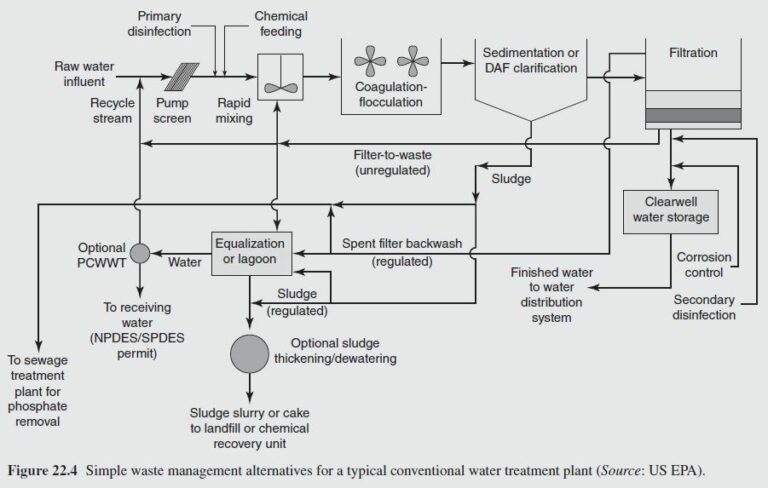Question 22.1: SIMPLE WASTE MANAGEMENT SYSTEMS FOR HANDLING/TREATING/RECYCL...
SIMPLE WASTE MANAGEMENT SYSTEMS FOR HANDLING/TREATING/RECYCLING SPENT FILTER BACKWASH WASTEWATER,WASTE SLUDGE, AND FILTER TO-WASTE AT CONVENTIONAL WATER TREATMENT PLANTS
A conventional WTP shown in Figs. 22.1 and 22.4 involves the use of screening, pumping, chemical feeding, rapid mixing, coagulation-flocculation, sedimentation (or flotation), filtration, corrosion control, and disinfection. The WTP is commonly used for treating surface water or GWUDI (groundwater under direct influence of surface water). After the impurities/contaminants are removed from raw water, the treated/finished water becomes suitable for consumption. The waste sludge from the sedimentation clarifier (or flotation clarifier) and the filter backwash wastewater from the filters are the regulated wastes requiring proper handling and disposal. The filter-to-waste water is unregulated. What is the simplest waste handling system for a conventional WTP assuming that (a) waste sludge in slurry form or cake form may be hauled away for landfill or chemical recycle and (b) an equalization basin or lagoon is to be used for waste holding, solids settling, water recycling, and sludge drying.


Learn more on how we answer questions.
There are three kinds of wastes produced from a filtration WTP: (a) the unregulated filter-to-waste water that is produced from filtration units during the final stage of filter backwash, before the filter is placed online for service; (b) the regulated waste sludge streams from the clarifiers (sedimentation or flotation); and (c) the regulated spent filter backwash wastewater. Figure 22.4 shows the flow diagram of the simplest waste management processes. Equalization is typically used for spent filter backwash and waste sludge, but may be used for other unregulated recycle streams such as filter-to-waste. Pumps may be required to convey the recycle streams from the equalization tank. Two case histories are listed below as typical examples of creative waste management:
1. Pittsfield WTP, Massachusetts, is a typical flotation-filtration plant consisting of presedimentation (reservoir), screening, pump, chemical feeding, primary disinfection, rapid mixing, flocculation, dissolved air flotation clarification, automatic backwash filtration (sand), secondary disinfection (chlorination), corrosion control, clearwell, and water storage and distribution. Pittsfield WTP discharges its spent filter backwash wastewater and waste sludge to the PittsfieldWWTPfor phosphate removal. Practically speaking, theWTP waste is recycled as phosphate removal chemical at a WWTP.With permission from the government, the water portion of the wastes (including the filter-to-waste) is recycled to the plant for production of drinking water. This option is feasible only when there is a municipal WWTP which needs phosphate removal and has enough hydraulic capacity to handle the WTP wastes (Wang, 1991).
2. Albany WTP, New York, is a typical conventional sedimentation-filtration plant consisting of presedimentation (reservoir), screening, pumping, spray aeration (VOC, taste and odor control), chemical feeding (coagulants, oxidants, PAC), primary disinfection (chlorination), rapid mixing, flocculation, sedimentation, filtration (sand), corrosion control, secondary disinfection (chlorination), clearwell, water storage, UV, and distribution. Albany WTP discharges its filter-to-waste, waste sludge, and spent filter backwash wastewater to four huge lagoons for flow equalization, solids settling, and sludge drying. The supernatant of the lagoon is discharged to a receiving stream with NPDES/SPDES permit. Every 10 years or so, a lagoon will be full of dry sludge. The dried sludge is then dredged and hauled away for landfill. No mechanical sludge thickening and dewatering units are needed. The huge lagoons serve as the waste treatment units. This option is feasible only when there is ample land space available for construction of large lagoons.